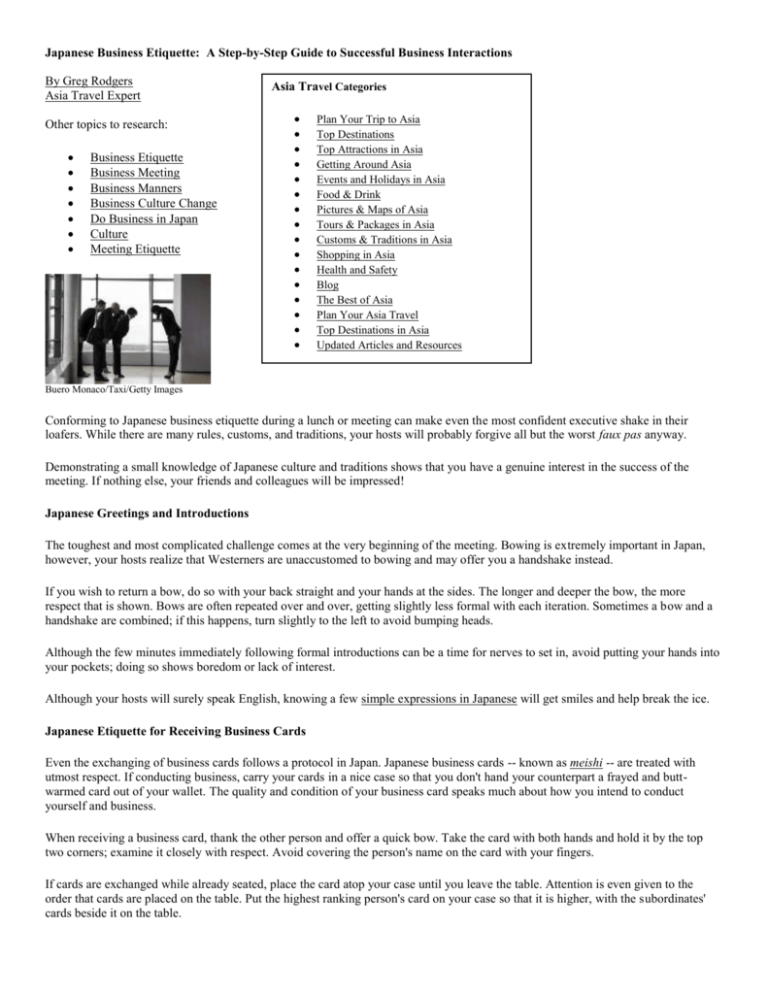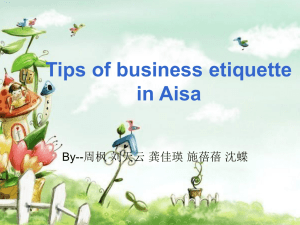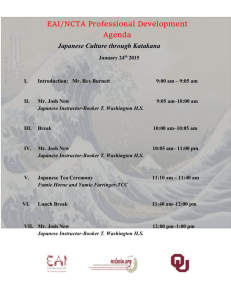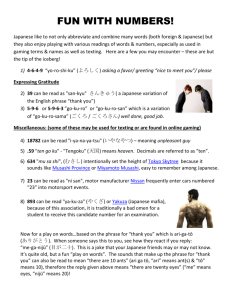Things to Avoid in Japanese Business Etiquette
advertisement

Japanese Business Etiquette: A Step-by-Step Guide to Successful Business Interactions By Greg Rodgers Asia Travel Expert Other topics to research: Business Etiquette Business Meeting Business Manners Business Culture Change Do Business in Japan Culture Meeting Etiquette Asia Travel Categories Plan Your Trip to Asia Top Destinations Top Attractions in Asia Getting Around Asia Events and Holidays in Asia Food & Drink Pictures & Maps of Asia Tours & Packages in Asia Customs & Traditions in Asia Shopping in Asia Health and Safety Blog The Best of Asia Plan Your Asia Travel Top Destinations in Asia Updated Articles and Resources Buero Monaco/Taxi/Getty Images Conforming to Japanese business etiquette during a lunch or meeting can make even the most confident executive shake in their loafers. While there are many rules, customs, and traditions, your hosts will probably forgive all but the worst faux pas anyway. Demonstrating a small knowledge of Japanese culture and traditions shows that you have a genuine interest in the success of the meeting. If nothing else, your friends and colleagues will be impressed! Japanese Greetings and Introductions The toughest and most complicated challenge comes at the very beginning of the meeting. Bowing is extremely important in Japan, however, your hosts realize that Westerners are unaccustomed to bowing and may offer you a handshake instead. If you wish to return a bow, do so with your back straight and your hands at the sides. The longer and deeper the bow, the more respect that is shown. Bows are often repeated over and over, getting slightly less formal with each iteration. Sometimes a bow and a handshake are combined; if this happens, turn slightly to the left to avoid bumping heads. Although the few minutes immediately following formal introductions can be a time for nerves to set in, avoid putting your hands into your pockets; doing so shows boredom or lack of interest. Although your hosts will surely speak English, knowing a few simple expressions in Japanese will get smiles and help break the ice. Japanese Etiquette for Receiving Business Cards Even the exchanging of business cards follows a protocol in Japan. Japanese business cards -- known as meishi -- are treated with utmost respect. If conducting business, carry your cards in a nice case so that you don't hand your counterpart a frayed and buttwarmed card out of your wallet. The quality and condition of your business card speaks much about how you intend to conduct yourself and business. When receiving a business card, thank the other person and offer a quick bow. Take the card with both hands and hold it by the top two corners; examine it closely with respect. Avoid covering the person's name on the card with your fingers. If cards are exchanged while already seated, place the card atop your case until you leave the table. Attention is even given to the order that cards are placed on the table. Put the highest ranking person's card on your case so that it is higher, with the subordinates' cards beside it on the table. The worst thing that you can possibly do in Japanese business etiquette is to cram someone's business card into a back pocket or wallet in front of them! Removing Your Shoes The number one rule to remember when entering a home or sitting area: remove your shoes! A wooden threshold or change in the flooring -- along with a pile of provided slippers -- will indicate where you should remove your outside shoes. Place your shoes on the provided rack or off to the side. Going in only socks is acceptable in informal situations, however, bare feet are rarely acceptable. If you wear sandals, bring a small pair of white socks with you for wearing so that your bare feet do not touch the provided slippers. If conducting business, make sure that you don't have any visible holes in your socks! Do not wear your hosts's slippers into the restroom -- which may be a squat toilet; a different set of "toilet" slippers should be waiting by the entrance. Even the slippers are removed when walking or sitting on the tatami mats. If unsure when to remove your shoes, simply follow your hosts' lead and do as they do! Things to Avoid in Japanese Business Etiquette Keep your hands out of your pockets while speaking to someone. Being invited to someone's home is a great honor. If one of your hosts extends an invitation, accept wholeheartedly. Unlike in China where people openly clear their noses onto the street, blowing your nose in public is generally frowned upon in Japanese etiquette. Excuse yourself to the toilet or go outside to clear your nose. Sniffling to avoid blowing the nose actually is acceptable. Avoid pointing at people with a finger to make a point. Pointing, whether with fingers or chopsticks, is considered especially rude in Japan. The numbers "4" and "9" are considered unlucky in Japanese culture. The word for four ( shi ) is the same as the word for death, while the word for nine ( ku ) can mean suffering. Avoid giving gifts or anything else in sets of four or nine. Many rules of Japanese business etiquette follow the rules of saving face. Avoid causing someone to "lose face" by pointing out their mistakes or shortcomings in front of others. Tipping is not customary in Japan, and is sometimes considered rude. Read more about tipping in Asia. Japanese Table Manners: After all introductions are made and cards have been exchanged, it's time for the fun part: the food! Related Articles Japanese Dining Etiquette When to Bow in Japan - Proper Etiquette Master these Japanese Greetings for a Better Experience in Japan Thailand Etiquette Dos and Don'ts Etiquette Tips for Men Don't Give White Flowers in Asia and Other Gift-Giving Etiquette Our Expert Recommends How to Say Hello in Japanese Japanese Drinking Etiquette Should You Tip in Japan? How to Eat Sushi Japanese Festivals Japan Travel Tips for Saving Money Etiquette in Asia Chinese Table Manners Etiquette in Thailand Returning Bows Knowing how much to bow is often pretty hard. It’s sort of a game of “guess who” where you try to figure out the other person’s age, status, company, etc., to figure out how much you need to humble yourself at their expense. There’s a few good ways to do this, though you’ll often find yourself just doing something in between (or overly respectful, just in case) because you don’t know enough about the other person. First though, here are some rules on bowing: You should bow back to people who bow at you (with a couple exceptions… i.e. people who greet you at stores / people who try to hand you things on the street). Try to get the other person’s business card (people hand out their business card like nothing in Japan). On it should be their company and title, which will give you an idea about where they are in the world. Try to guess how old they are. Chances are, if they’re older than you, they’re above you in almost every way. Treat your elders with respect. Facts about Japan In 1603, a Tokugawa shogunate (military dictatorship) ushered in a long period of isolation from foreign influence in order to secure its power. For more than two centuries this policy enabled Japan to enjoy stability and a flowering of its indigenous culture. Following the Treaty of Kanagawa with the US in 1854, Japan opened its ports and began to intensively modernize and industrialize. During the late 19th and early 20th centuries, Japan became a regional power that was able to defeat the forces of both China and Russia. It occupied Korea, Formosa (Taiwan), and southern Sakhalin Island. In 1931-32 Japan occupied Manchuria, and in 1937 it launched a full-scale invasion of China. Japan attacked US forces in 1941 - triggering America's entry into World War II - and soon occupied much of East and Southeast Asia. After its defeat in World War II, Japan recovered to become an economic power and a staunch ally of the US. While the emperor retains his throne as a symbol of national unity, elected politicians - with heavy input from bureaucrats and business executives - wield actual decisionmaking power. The economy experienced a major slowdown starting in the 1990s following three decades of unprecedented growth, but Japan still remains a major economic power, both in Asia and globally. Geography of Japan Location: Eastern Asia, island chain between the North Pacific Ocean and the Sea of Japan, east of the Korean Peninsula Coordinates: 36 00 N, 138 00 E Area: total: 377,835 sq km note: includes Bonin Islands (Ogasawara-gunto), Daito-shoto, Minami-jima, Okino-tori-shima, Ryukyu Islands (Nansei-shoto), and Volcano Islands (Kazan-retto) water: 3,091 sq km land: 374,744 sq km Area comparative: slightly smaller than California Land boundaries: 0 km Coastline: 29,751 km Maritime claims: contiguous zone: 24 NM territorial sea: 12 NM; between 3 NM and 12 NM in the international straits La Perouse or Soya, Tsugaru, Osumi, and Eastern and Western Channels of the Korea or Tsushima Strait exclusive economic zone: 200 NM Climate: varies from tropical in south to cool temperate in north Terrain: mostly rugged and mountainous Elevation lowest point: Hachiro-gata -4 m extremes: highest point: Mount Fuji 3,776 m Natural resources: negligible mineral resources, fish Natural hazards: many dormant and some active volcanoes; about 1,500 seismic occurrences (mostly tremors) every year; tsunamis; typhoons Environment air pollution from power plant emissions results in acid rain; acidification of current issues: lakes and reservoirs degrading water quality and threatening aquatic life; Japan is one of the largest consumers of fish and tropical timber, contributing to the depletion of these resources in Asia and elsewhere Geography - note: strategic location in northeast Asia Population of Japan Population: Age structure: 127,288,416 (July 2008 est.) 0-14 years: 14.2% (male 9,309,524/female 8,849,476) 15-64 years: 65.7% (male 42,158,122/female 41,611,754) 65 years and over: 20% (male 10,762,585/female 14,772,150) Median age: 42.9 years Growth rate: 0.02% Infant mortality: 3.24 deaths/1,000 live births Life expectancy at total population: 81.25 years birth: male: 77.96 years female: 84.7 years Fertility rate: 1.4 children born/woman Nationality: noun: Japanese (singular and plural) adjective: Japanese Ethnic groups: Japanese 99%, others 1% (Korean 511,262, Chinese 244,241, Brazilian 182,232, Filipino 89,851, other 237,914) note: up to 230,000 Brazilians of Japanese origin migrated to Japan in the 1990s to work in industries; some have returned to Brazil (2004) Religions: observe both Shinto and Buddhist 84%, other 16% (including Christian 0.7%) Languages: Japanese Literacy: definition: age 15 and over can read and write total population: 99% Government Government type: Capital: Administrative divisions: constitutional monarchy with a parliamentary government Tokyo 47 prefectures; Aichi, Akita, Aomori, Chiba, Ehime, Fukui, Fukuoka, Fukushima, Gifu, Gumma, Hiroshima, Hokkaido, Hyogo, Ibaraki, Ishikawa, Iwate, Kagawa, Kagoshima, Kanagawa, Kochi, Kumamoto, Kyoto, Mie, Miyagi, Miyazaki, Nagano, Nagasaki, Nara, Niigata, Oita, Okayama, Okinawa, Osaka, Saga, Saitama, Shiga, Shimane, Shizuoka, Tochigi, Tokushima, Tokyo, Tottori, Toyama, Wakayama, Yamagata, Yamaguchi, Yamanashi Independence: 660 BC (traditional founding by Emperor Jimmu) National holiday: Birthday of Emperor AKIHITO, 23 December (1933) Constitution: 3 May 1947 Legal system: modeled after European civil law system with English-American influence; judicial review of legislative acts in the Supreme Court; accepts compulsory ICJ jurisdiction with reservations Suffrage: 20 years of age; universal Executive branch: chief of state: Emperor AKIHITO (since 7 January 1989) head of government: Prime Minister Taro ASO (since 24 September 2008) cabinet: Cabinet appointed by the prime minister elections: Diet designates prime minister; constitution requires that prime minister commands parliamentary majority; following legislative elections, leader of majority party or leader of majority coalition in House of Representatives usually becomes prime minister; monarch is hereditary. Legislative bicameral Diet or Kokkai consists of the House of Councillors or Sangi-in branch: (242 seats - members elected for six-year terms; half reelected every three years; 146 members in multi-seat constituencies and 96 by proportional representation) and the House of Representatives or Shugi-in (480 seats members elected for four-year terms; 300 in single-seat constituencies; 180 members by proportional representation in 11 regional blocs) Judicial branch: Supreme Court (chief justice is appointed by the monarch after designation by the cabinet; all other justices are appointed by the cabinet) Political parties Democratic Party of Japan or DPJ [Ichiro OZAWA]; Japan Communist Party and leaders: or JCP [Kazuo SHII]; Komeito [Takenori KANZAKI]; Liberal Democratic Party or LDP [Junichiro KOIZUMI]; Social Democratic Party or SDP [Mizuho FUKUSHIMA] Economy Government-industry cooperation, a strong work ethic, mastery of high technology, and a comparatively small defense allocation (1% of GDP) helped Japan advance with extraordinary rapidity to the rank of second most technologically powerful economy in the world after the US and the third-largest economy in the world after the US and China, measured on a purchasing power parity (PPP) basis. One notable characteristic of the economy has been how manufacturers, suppliers, and distributors have worked together in closely-knit groups called keiretsu. A second basic feature has been the guarantee of lifetime employment for a substantial portion of the urban labor force. Both features have now eroded. Japan's industrial sector is heavily dependent on imported raw materials and fuels. The tiny agricultural sector is highly subsidized and protected, with crop yields among the highest in the world. Usually self sufficient in rice, Japan must import about 55% of its food on a caloric basis. Japan maintains one of the world's largest fishing fleets and accounts for nearly 15% of the global catch. For three decades, overall real economic growth had been spectacular - a 10% average in the 1960s, a 5% average in the 1970s, and a 4% average in the 1980s. Growth slowed markedly in the 1990s, averaging just 1.7%, largely because of the after effects of overinvestment and an asset price bubble during the late 1980s that required a protracted period of time for firms to reduce excess debt, capital, and labor. From 2000 to 2001, government efforts to revive economic growth proved short lived and were hampered by the slowing of the US, European, and Asian economies. In 2002-07, growth improved and the lingering fears of deflation in prices and economic activity lessened, leading the central bank to raise interest rates to 0.25% in July 2006, up from the near 0% rate of the six years prior, and to 0.50% in February 2007. In addition, the 10-year privatization of Japan Post, which has functioned not only as the national postal delivery system but also, through its banking and insurance facilities as Japan's largest financial institution, was completed in October 2007, marking a major milestone in the process of structural reform. Nevertheless, Japan's huge government debt, which totals 182% of GDP, and the aging of the population are two major longrun problems. Some fear that a rise in taxes could endanger the current economic recovery. Debate also continues on the role of and effects of reform in restructuring the economy, particularly with respect to increasing income disparities. GDP: GDP growth rate: GDP per capita: GDP composition by sector: Inflation rate: Labor force: Labor force - by occupation: Unemployment: Budget: Electricity production by source: Industries: Agriculture: Exports: Export partners: Imports: Import partners: Currency: $4.272 trillion (2007 est.) 2.7% $31,500 agriculture: 1.7% industry: 25.8% services: 72.5% -0.3% 66.4 million agriculture: 4.6% industry: 27.8% services: 67.7% 4.4% revenues: $1.429 trillion expenditures: $1.775 trillion fossil fuel: 60% hydro: 8.4% other: 1.8% nuclear: 29.8% among world's largest and technologically advanced producers of motor vehicles, electronic equipment, machine tools, steel and nonferrous metals, ships, chemicals, textiles, processed foods rice, sugar beets, vegetables, fruit, pork, poultry, dairy products, eggs, fish transport equipment, motor vehicles, semiconductors, electrical machinery, chemicals US 22.9%, China 13.4%, South Korea 7.8%, Taiwan 7.3%, Hong Kong 6.1% machinery and equipment, fuels, foodstuffs, chemicals, textiles, raw materials China 21%, US 12.7%, Saudi Arabia 5.5%, UAE 4.9%, South Korea 4.7%, Australia 4.4%, Indonesia 4% yen (JPY) SOURCES: The CIA World Factbook, U.S. Department of State, Area Handbook of the US Library of Congress









